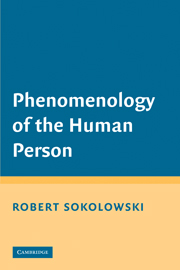Book contents
- Frontmatter
- Contents
- Acknowledgments
- Phenomenology of the Human Person
- Introduction
- PART I THE FORM OF THINKING
- PART II THE CONTENT OF THINKING
- PART III THE BODY AND HUMAN ACTION
- 12 The Body and the Brain
- 13 Active Perception and Declaratives
- 14 Mental Images and Lenses
- 15 Forms of Wishing
- 16 Declaring Our Wishes and Choices
- PART IV ANCIENTS AND MODERNS
- 19 Conclusion, with Henry James
- Bibliography
- Index
15 - Forms of Wishing
Published online by Cambridge University Press: 05 June 2012
- Frontmatter
- Contents
- Acknowledgments
- Phenomenology of the Human Person
- Introduction
- PART I THE FORM OF THINKING
- PART II THE CONTENT OF THINKING
- PART III THE BODY AND HUMAN ACTION
- 12 The Body and the Brain
- 13 Active Perception and Declaratives
- 14 Mental Images and Lenses
- 15 Forms of Wishing
- 16 Declaring Our Wishes and Choices
- PART IV ANCIENTS AND MODERNS
- 19 Conclusion, with Henry James
- Bibliography
- Index
Summary
We get a glimpse of the human person in the declarative use of the word I. For another perspective on the personal, we now turn to the phenomena of human choice and human intentions. To get a good view of these things, let us, like photographers, arrange a background, a context in which the target can be brought into sharper focus. We will not just speak about human beings, but will place them against plants and animals, and will discuss the logic of needing, wanting, and wishing. We will then explore the human person as an agent or an actor.
We will, therefore, highlight the human person by placing him against the background of prepersonal phenomena. Our procedure here will be analogous to what we did when we positioned language, with its syntax, against the background of protolanguage and mere vocalization. In this case, however, we will be dealing not just with cognition but with desire and conduct.
Needs, Wants, and Wishes
Plants need certain things: they need light, water, and nourishment. A plant takes in certain things from its environment and makes them part of itself in order to keep itself alive. It could not remain itself without metabolizing other things into itself; it needs these other things. Need is associated with life.
- Type
- Chapter
- Information
- Phenomenology of the Human Person , pp. 238 - 252Publisher: Cambridge University PressPrint publication year: 2008

